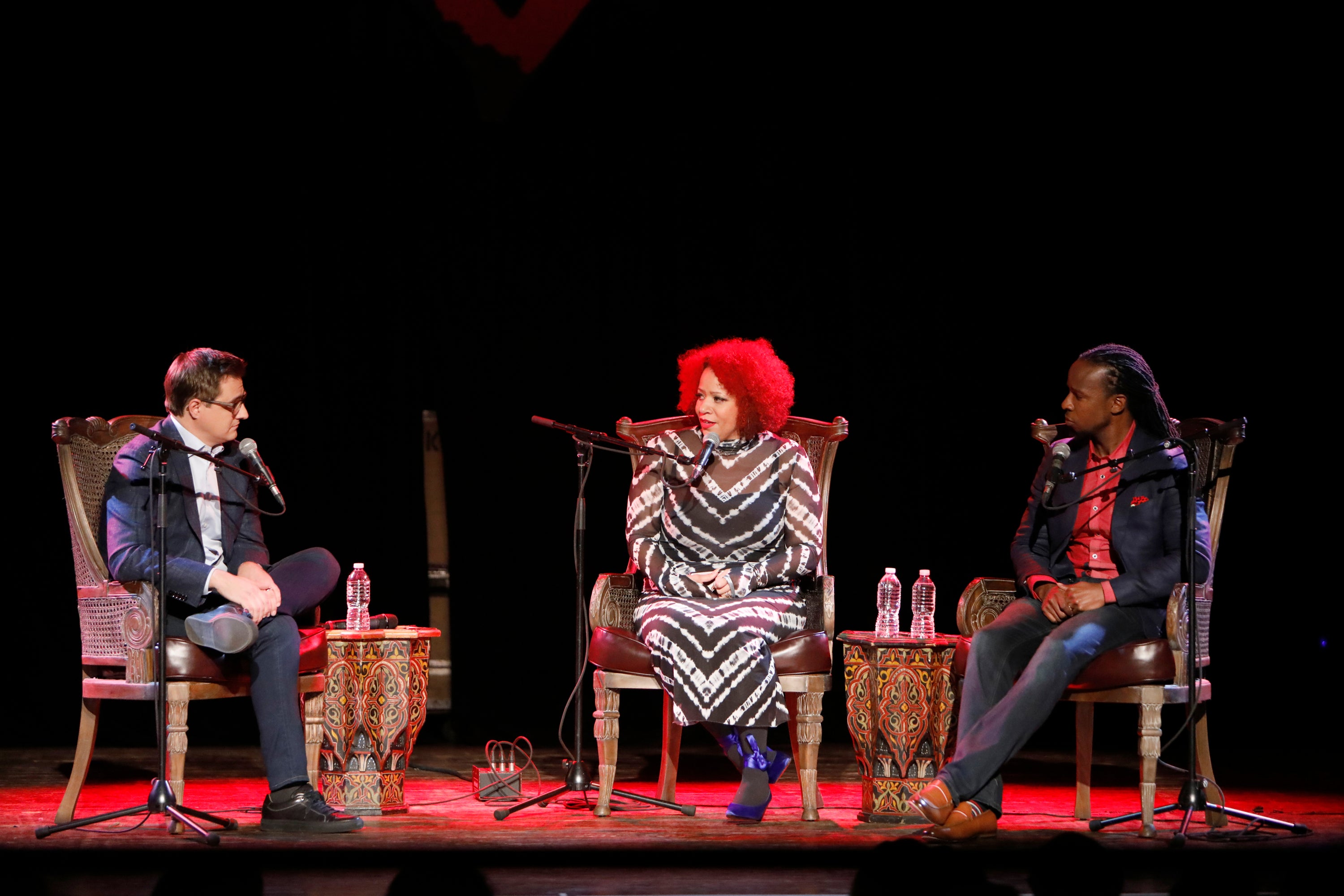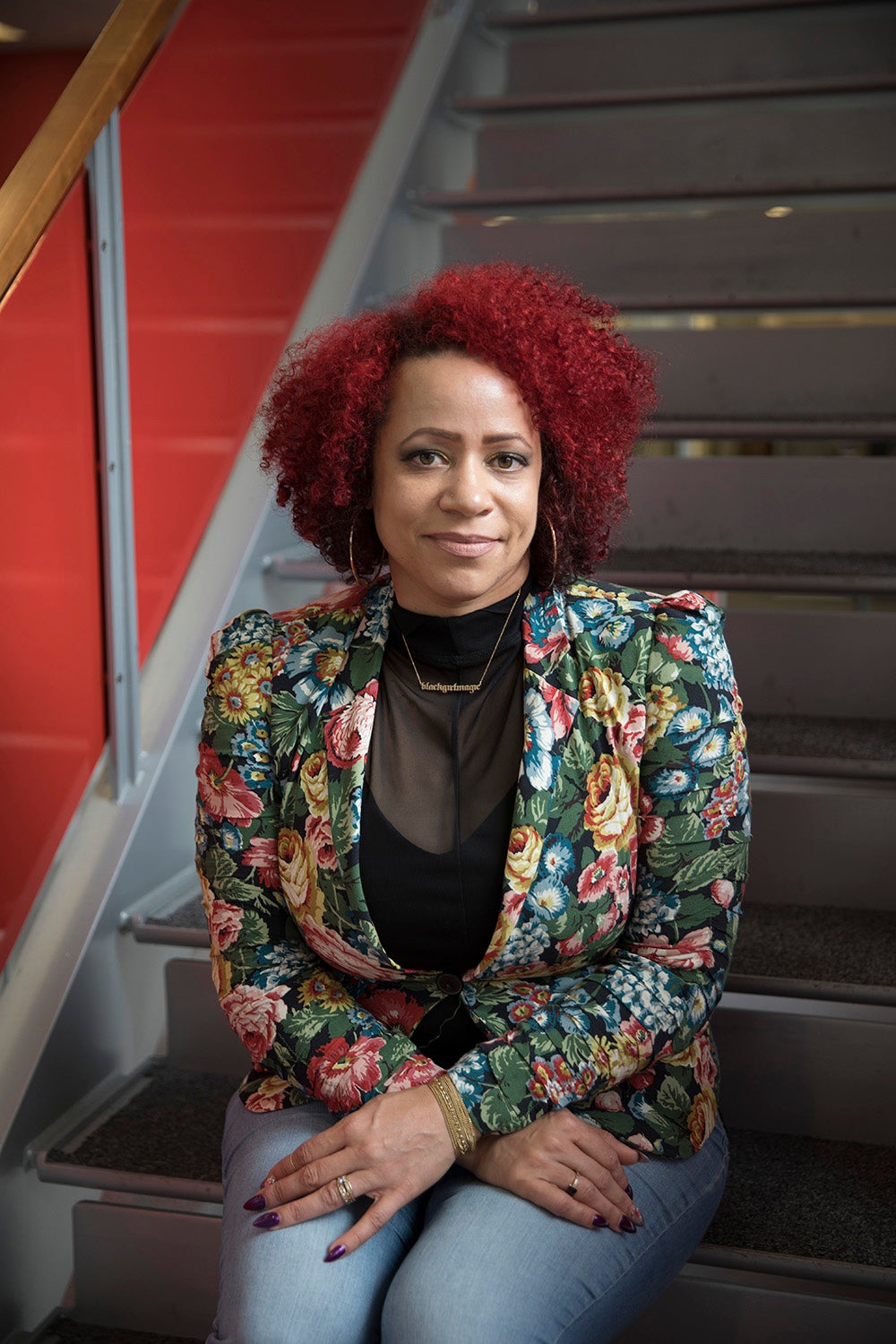On August 18th, 2019 it seemed almost everyone was hunting for a copy of New York Times Magazine. They even sold out, twice. So many wanted to hold a piece of history in their hands — the inaugural issue of The 1619 Project, brainchild of reporter Nikole Hannah-Jones.
The project was a reckoning, solely focused on the undeniable truth that the United States could not exist — not its wealth, status, or culture — without slavery. Hannah-Jones forced a nation in deep denial to turn its searing gaze inward, to recognize the extent and continuation of its injustice and brutality.
Hannah-Jones tells ESSENCE that the 1619 Project “unsettles our national narrative. It unsettles the idea of American exceptionality. It does not deify our founding or our founders.”
Released on the 400th anniversary of the arrival of enslaved Africans to Virginia and consisting of work by Black writers, artists, scholars, and thought leaders, this epic project is a collection of reported essays, photo essays, poems, and a podcast. In an industry that is overwhelming white-led, that Hannah-Jones — a Black woman reporter — directed a project of this magnitude with a nearly all-Black team was groundbreaking.

Hannah-Jones says she’s “very proud” of what she and her team were able to accomplish. But reflecting on the experience, she says, brings memories of both difficulties and joyous moments. “Spending eight months literally immersed in the atrocities that have been committed against your ancestors, with no real break… was very emotionally taxing,” she says. “The other difficult thing was just the immense pressure to get this right, to create a project that Black people would be proud of. And that was a pressure I felt every single day. It was both difficult and motivating.” But for her, the overwhelmingly positive response the project received from the Black community was the most joyous time of all.
The 1619 Project is far from over. It will continue to feature more essays and art. The New York Times Magazine teamed up with the Pulitzer Center on Crisis Reporting, producing a free online curriculum for educators that, according to the center, more than 1,000 teachers are planning to use in their classes. Hannah-Jones tells ESSENCE they’re planning to expand that curriculum, in addition to adding a series of children’s books.
And Hannah-Jones is continuing beyond as well, taking the spirit of revelation and confrontation that imbued the 1619 Project to other areas of racial injustice. This, she says, is the work she’s always been drawn to. “What really drove me towards doing investigative work [was] not just writing that inequality exists, but really trying to unearth the mechanisms behind it and the people responsible for it.”

A recipient of the MacArthur Fellowship, a prestigious award often called the “genius grant,” Hannah-Jones says that in her career, “I’ve always written about the worst side of America.”
Along with her upcoming book, “The Problem We All Live With,” a large part of that work has included documenting the pervasiveness and “persistence” of racial segregation in the United States.
Published in The New York Times Magazine, one of her most influential pieces was the June 2016 article “Choosing a School for My Daughter in a Segregated City.” Weaving in incisive analysis about the past and present of school segregation in the U.S., Hannah-Jones takes readers on a personal journey. Should she and her husband send their daughter to a racially segregated school with little resources? Or should they send her to a school with more opportunities — even if those opportunities were made available because of racial injustice? In the end, Hannah-Jones and her husband decided to enroll their daughter in the segregated school, where they could help change the system.
Hannah-Jones says both her personal and professional experiences with school segregation have made it clear to her that, “Our schools are not broken. They are operating as designed, they’re operating to maintain a system of caste where black children largely will be educated in an environment that will not allow them to compete with white Americans.”
Though Hannah-Jones’ work has always centered the “community over the individual,” she acknowledges that “There’s certainly a difference… in having to navigate a school system as a parent trying to secure an education for your child as opposed to a reporter.”
But even though this system is designed to work against her and those she loves, Hannah-Jones isn’t filled with fear. “Because I’ve written about this, I think I have less fear because I understand exactly how the system works and I understand exactly what the system is going to try to do to my child. As best as one can be prepared, I am prepared. And what that has allowed me to do is prepare my child.”
Hannah-Jones is also preparing other Black journalists and creators to do the work that will help our communities.
As a co-founder of the Ida B. Wells Society for Investigative Reporting, Hannah-Jones says “For those of us who get the opportunity to rise in our profession and get into spaces where there are not many who look like us, it’s our job to open the door and help pull other black journalists and journalists of color through.”
The society’s namesake, Ida B. Wells, was a Black woman investigative journalist who was incredibly persistent in revealing the depth of racial injustice and terror in this country. For Hannah-Jones, the name of the society is significant because “We have a very long legacy and tradition as Black people of investigative reporting. One of the baddest investigative reporters of any race or gender, was a Black woman who actually innovated both investigative and data journalism techniques,” she tells ESSENCE.
The spirit of Wells’ work permeates Hannah-Jones’ own reporting, which pushes back against the false notion that “real” journalism is and should be objective.
“We understand as Black people that there’s never been a day in America where journalism has been able to be objective. What’s important to us is to acknowledge that we’re all coming to these stories with a background, with a way of seeing the world,” Hannah-Jones says. “That determines what stories we tell and what stories we don’t tell. It’s only in that honesty that we can even get close to producing journalism that is reflective of the realities of our communities.”
Part of the power of The 1619 Project was how much it validated Black history, Black pain, while condemning the brutality behind it. This frankness resulted in conservative outrage being thrown at both Hannah-Jones and the project, even from some of the most prominent leaders in the country. On the day it was released, Republican and former Speaker of the House Newt Gingrich tweeted, “The NY Times 1619 Project should make its slogan ‘All the Propaganda we want to brainwash you with’.it is a repudiation of the original NY Times motto.”
In December 2019, along with an emphatic and thorough rebuttal from Editor-in-Chief Jake Silverstein, the New York Times Magazine published a letter from a small group of historians who felt that the 1619 Project contained several “inaccuracies” about the extent of racial injustice in the United States.
Hannah-Jones acknowledges that some of the criticism was constructive and “in good faith,” pointing out that they plan to incorporate such useful criticism into the curriculum. However, when it comes to indignant letters and racist tweets meant to discredit the project, Hannah-Jones says “While it seemed like there’s been a lot of pushback, there’s actually been a very small number of folks that have very big megaphones and vested interests in maintaining our national narrative.”
In reality, the 1619 Project’s impact on communities will always overshadow the hate thrown at it. Hannah-Jones says that “There’s nothing they can do to prevent this from having any meaning to our people. It still means the same thing it did to them today as it did when it came out.”
In the interview, Hannah-Jones agreed that her work was a tapestry of Black resistance and creation in this critical age of looming facism, injustice, and societal transformation, saying “It’s an amazing time to be a Black journalist and I do feel as if we are in a bit of a Renaissance.”
She continues, musing “I think as Black journalists, our tradition has been that we are always in conversation with the artists in our communities as well. All of our work leading towards liberation, just using different tools. Look at the black filmmakers right now, look at the black playwrights right now, look at the black fine artists right now. It is a beautiful time.”
When asked how she hopes history will remember The 1619 Project, Hannah-Jones tells ESSENCE, “Journalism… in this country has largely been used to obscure the narrative of slavery and to obscure the contributions of black Americans. I hope [The 1619 Project] will be remembered as the project where the descendants of the enslaved harnessed the power of a tool that was once used for white supremacy in order to bend that narrative and to change the way that our country sees itself and that our country sees us. I think that there is a tremendous power in that.”

